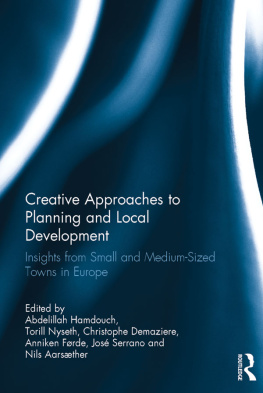ADDRESSING URBAN SHRINKAGE IN SMALL AND MEDIUM SIZED TOWNS
Shrink Smart and Re-grow Smaller
BY
HANS SCHLAPPA
University of Hertfordshire, UK
And
TATSUYA NISHINO
Kanazawa University, Japan
United Kingdom North America Japan India
Malaysia China
Emerald Publishing Limited
Howard House, Wagon Lane, Bingley BD16 1WA, UK
First edition 2021
Copyright 2021 Hans Schlappa and Tatsuya Nishino
Published under exclusive licence by Emerald Publishing Limited
Reprints and permissions service
Contact:
No part of this book may be reproduced, stored in a retrieval system, transmitted in any form or by any means electronic, mechanical, photocopying, recording or otherwise without either the prior written permission of the publisher or a licence permitting restricted copying issued in the UK by The Copyright Licensing Agency and in the USA by The Copyright Clearance Center. Any opinions expressed in the chapters are those of the authors. Whilst Emerald makes every effort to ensure the quality and accuracy of its content, Emerald makes no representation implied or otherwise, as to the chapters' suitability and application and disclaims any warranties, express or implied, to their use.
British Library Cataloguing in Publication Data
A catalogue record for this book is available from the British Library
ISBN: 978-1-80043-697-8 (Print)
ISBN: 978-1-80043-696-1 (Online)
ISBN: 978-1-80043-698-5 (Epub)
To Hannah, Daniel and Lucy who were there in the hour of need
CONTENTS
LIST OF FIGURES
| Figure 3.1. | Negative Development Spiral. | 12 |
| Figure 3.2. | An Older Resident Takes Her Newspapers to the Local Recycling Facility in Suzu, Japan. | 14 |
| Figure 3.3. | Change of Population and Municipal Tax Revenue in Suzu, Japan, 20092017 (Thousand JPY) (Suzu City, 2013, 2019). | 16 |
| Figure 3.4. | Change of Municipal General Account of Expense in Suzu, Japan, 20092017 (Thousand JPY) (Suzu City, 2013, 2019). | 16 |
| Figure 3.5. | Change in Long-Term Care Insurance Expenses for People 65 Years and Older in Suzu, Japan (Thousand JPY). | 17 |
| Figure 4.1. | Population Change in Japan, 2015 (Shimizu, 2020). | 27 |
| Figure 4.2. | Shrinking Towns in Germany. | 32 |
| Figure 4.3. | Japanese Model. | 35 |
| Figure 4.4. | German Model. | 35 |
| Figure 4.5. | United Kingdom Model | 36 |
| Figure 5.1. | Small and Medium Sized Towns Shrink Smart and Re-grow Smaller. | 39 |
| Figure 6.1. | The Enhancement of the River Front Before and After. | 47 |
| Figure 6.2. | Creation of an Elevator Which Links a National Visitor Attraction on a Hill above the Town to the Town Centre. | 48 |
| Figure 6.3. | Cycle of Decline and Development. | 49 |
| Figure 7.1. | Stages and Levels of Co-production (Schlappa, Imani, & Nishino, 2021). | 58 |
| Figure 7.2. | Placemaking Outside the Community Sitting Room. | 63 |
| Figure 7.3. | Seasonal Pub and Art Gallery in Aluksne, Slovenia of the Aluksne Pop-up Shop Initiative. | 65 |
| Figure 7.4. | The Anchor Shop in Melgao. | 66 |
| Figure 7.5. | Reconfiguring Medical Service Provision in Rural Japan. | 67 |
| Figure 7.6. | Mobile Postal Service UK. | 68 |
| Figure 7.7. | After Rightsizing the Urban Fabric, Marzahn-Hellersdorf, Berlin. | 70 |
| Figure 7.8. | Abandoned Residential Apartment Block in Yubari, Japan. | 71 |
| Figure 7.9. | Smart Urban Shrinkage Plan in Yubari, Japan. | 72 |
| Figure 7.10. | Block Heating Infrastructure Left after Demolition. | 73 |
| Figure 7.11. | The 20 20 m2 Plots at the Envisioning Stage Marked in Red and Then after Adoption by Residents. | 74 |
| Figure 7.12. | The ABC Model for Strategic Brownfield Land Management (Ferber & Preuss, 2006). | 75 |
| Figure 7.13. | A Street Where Refurbishment is Ongoing, Granby Four Streets, Liverpool, UK. | 77 |
| Figure 8.1. | Integrating Top-down and Bottom-up Policy to Tackle Long-term Decline. | 83 |
LIST OF ABBREVIATIONS
| IBA | International Building Exhibition |
| JPY | Japanese Yen |
| SMTs | small and medium sized towns |
ABOUT THE AUTHORS
Hans Schlappa is Senior Lecturer in Public Management at Hertfordshire University Business School. He has led several knowledge exchange networks on integrated approaches to urban regeneration. His research and teaching are centred around leadership the co-production of public services, public governance, and strategic management of public services. Prior to his academic career Dr Schlappa worked for 20 years in public and third sector organisations where he managed regeneration initiatives aimed at the socio-economic development of deprived urban areas and the reclamation of derelict land. Hans has extensive experience in undertaking practice oriented research, including assignments for the UK government, local government and third sector organisations.
Tatsuya Nishino is a Professor at Kanazawa University in Japan. He holds a doctoral degree obtained at Department of Architecture, Faculty of Engineering, the University of Tokyo in 2005. He started his teaching career as Assistant Professor at Hiroshima University in 2005 and moved to Kanazawa University in 2009. In 2019, he stayed at the University of Hertfordshire as a visiting scholar for his sabbatical leave. Over the past 15 years his research has focused on facility planning for the provision of older people's services and on planning processes to re-organise public service providing facilities in cities affected by population loss. He co-edited a book in 2015 on methods for re-organisation of public service providing facilities in Japan. He received the Prize of AIJ 2019 from Architectural Institute of Japan for his studies on facility planning.
1
INTRODUCTION
In the twenty-first century, the management of shrinkage and decline, rather than economic growth, has become the strategic objective for a large number of urban settlements. Contemporary studies show how global trends enable large cities to grow, even in adverse economic conditions, while smaller towns become locked into long-term decline (Martinez-Fernandez, Kubo, Noya, & Weyman, 2012; UN-Habitat, 2008). The rapidly growing body of research on urban shrinkage provides a complex picture of the seemingly intractable problems arising from economic restructuring, demographic change, migration, sub-urbanisation, environmental shocks and political upheavals. Local leaders are unfamiliar with developing responses that diverge from accepted notions of achieving economic growth and every failure to restore a city's fortunes adds to a prevailing sense of resignation and confusion. A key challenge is to put forward plausible proposals for how to bridge the gap between a town's, often prosperous, past and a future that promises an improvement on the continuous decline that inhabitants experience. It is entirely understandable that politicians, officials and residents can find it difficult to accept that their town is shrinking, which refers to a reduction in its overall size, or declining which infers deterioration and being on a downward path. However, being in denial about this reality makes it difficult to develop effective pathways that would address the challenges arising from long-term decline and shrinkage.











